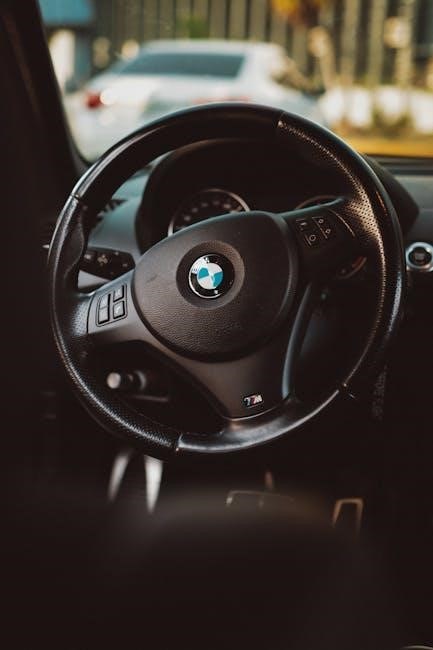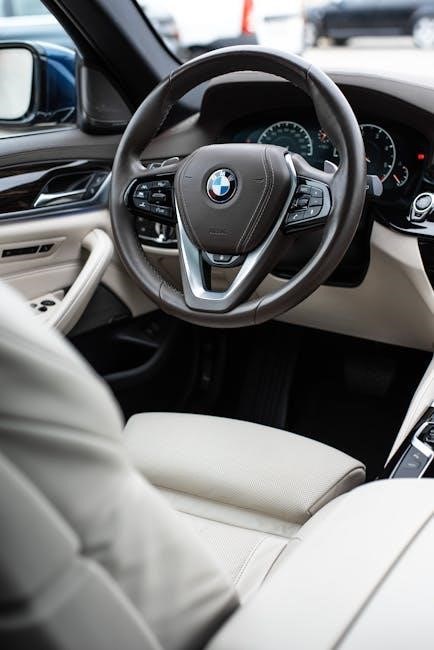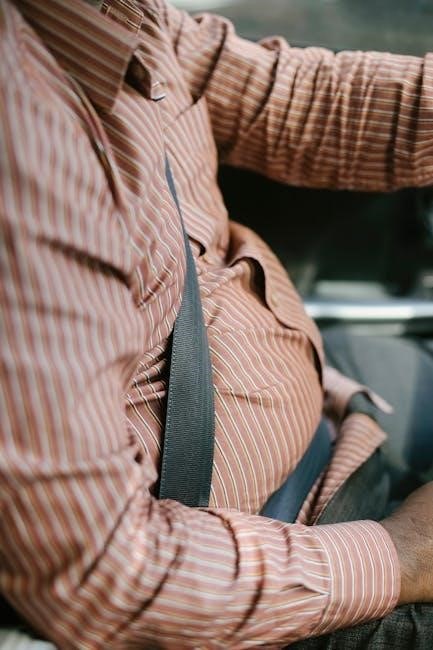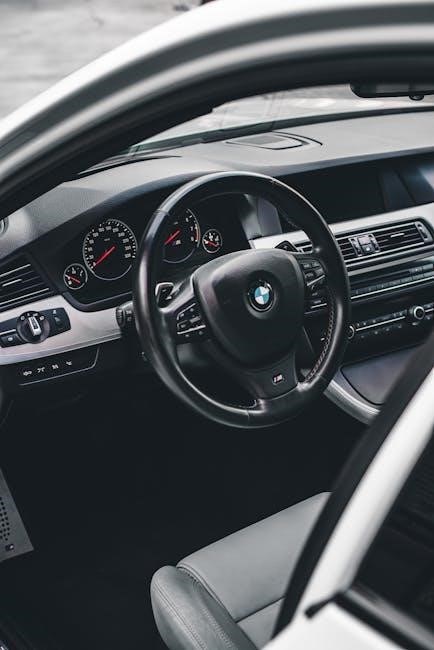Seat belts are a critical safety feature in the BMW Z3, designed to protect occupants during sudden stops or collisions. This guide explores their functionality, components, and maintenance.

The Importance of Seat Belts in Vehicle Safety

Seat belts are essential for vehicle safety, significantly reducing the risk of fatal injuries or severe harm in accidents. By securing occupants in their seats, they prevent ejection and minimize collision forces. Airbags work most effectively when seat belts are worn, ensuring proper restraint. Seat belts also maintain driver control during sudden maneuvers, reducing accidents. Legal requirements worldwide mandate their use, underscoring their critical role in road safety. Proper seat belt use is vital for protecting all vehicle occupants, making them a cornerstone of automotive safety systems.
Overview of the BMW Z3 Seat Belt System
The BMW Z3 seat belt system is a sophisticated safety feature designed to maximize occupant protection. It includes retractors, buckles, and webbing that work in harmony to ensure proper restraint. The system is integrated with the vehicle’s airbag system for enhanced safety. Pyrotechnic pre-tensioners tighten the belts instantly in the event of a collision, minimizing occupant movement. Force limiters regulate the belt’s tension to reduce the risk of injury from the belt itself. The Z3’s seat belts are made from high-quality materials, ensuring durability and reliability. Regular maintenance, such as checking for wear and proper function, is crucial to ensure the system operates effectively. This comprehensive design reflects BMW’s commitment to providing advanced safety solutions for its drivers and passengers.

Key Features of the BMW Z3 Seat Belt
The BMW Z3 seat belts are designed for optimal safety, featuring advanced retraction systems, durable materials, and intuitive designs to enhance occupant protection during driving.
Pyrotechnic Pre-Tensioners
Pyrotechnic pre-tensioners are a vital component of the BMW Z3 seat belt system, designed to enhance safety during sudden impacts or collisions. These devices use a small explosive charge to rapidly tighten the seat belt, eliminating slack and ensuring the occupant is securely restrained. This instantaneous response is crucial for minimizing movement and reducing the risk of injury. The pre-tensioners are engineered to activate in tandem with the vehicle’s airbag system, providing a coordinated safety response. By integrating this advanced technology, BMW ensures that the Z3’s seat belts deliver exceptional protection, aligning with the brand’s commitment to innovation and occupant safety. This feature underscores the importance of modern safety systems in vintage and classic vehicles like the BMW Z3.
Force Limiters for Enhanced Safety
Force limiters in the BMW Z3 seat belt system play a crucial role in enhancing occupant safety by regulating the force applied to the body during a collision. These devices are designed to reduce the risk of injury caused by the seat belt itself. By allowing a controlled amount of seat belt webbing to spool out during impact, force limiters help distribute the energy of the crash more evenly across the occupant’s body. This reduces the likelihood of chest or shoulder injuries, which can occur when the seat belt applies excessive force. The integration of force limiters complements the pre-tensioners, creating a balanced safety system that prioritizes both restraint and comfort. This advanced feature highlights BMW’s dedication to optimizing occupant protection in the Z3.
Components of the BMW Z3 Seat Belt System

The BMW Z3 seat belt system comprises retractors, buckles, and high-strength webbing, working together to ensure optimal occupant restraint and safety during various driving conditions.
Retractors and Their Function
Retractors are essential components of the BMW Z3 seat belt system, responsible for winding and unwinding the seat belt webbing smoothly. They ensure the belt remains taut during normal driving conditions and locks instantly in the event of sudden deceleration or impact. Equipped with advanced locking mechanisms, retractors prevent excessive belt movement, providing consistent restraint. In the BMW Z3, retractors are designed to work seamlessly with other components, such as pretensioners and force limiters, to optimize occupant safety. Regular maintenance of retractors is crucial to ensure their reliability and performance. Proper function guarantees the seat belt system operates as intended, offering both safety and comfort for drivers and passengers alike.
Buckles and Latches
Buckles and latches are vital components of the BMW Z3 seat belt system, ensuring secure and reliable fastening. The buckle is designed to seamlessly integrate with the latch, providing a snug and durable connection. Crafted from high-quality materials, these components are built to withstand the rigors of daily use while maintaining their functionality. In the BMW Z3, the latch mechanism is engineered to engage smoothly, offering a satisfying “click” when the belt is fastened. The buckle features an ergonomic design for easy operation, even while driving. Both components work in harmony to ensure the seat belt remains securely fastened, minimizing movement during sudden stops or sharp maneuvers. Proper maintenance of buckles and latches is essential to preserve their reliability and ensure optimal safety performance.
Seat Belt Webbing and Material Quality
The seat belt webbing in the BMW Z3 is designed for durability and strength, ensuring optimal protection during sudden stops or collisions. Made from high-strength polyester or nylon, the webbing is resistant to abrasion, UV exposure, and temperature fluctuations; The material is carefully woven to provide a balance between flexibility and rigidity, allowing it to absorb and distribute force effectively. BMW employs advanced stitching techniques to reinforce the webbing, preventing tears or fraying over time. The webbing is also treated with specialized coatings to enhance its resistance to wear and tear. Regular inspection of the webbing is crucial to identify any signs of damage or degradation, ensuring the seat belt performs as intended in critical situations. High-quality materials and construction ensure the BMW Z3 seat belt webbing remains reliable and safe for years of use.

Installation and Maintenance of BMW Z3 Seat Belts
Proper installation ensures functionality, while regular maintenance, including inspections and replacements, guarantees long-term safety and reliability of the seat belt system in the BMW Z3.
Step-by-Step Guide to Installing Seat Belts
Installing seat belts in your BMW Z3 requires precision to ensure safety and functionality. Start by disconnecting the car’s battery to prevent any accidental triggers. Locate the mounting points for the seat belt system, typically found on the floorpan, seat frame, or door sill. Use a Torx or Allen wrench to remove the old or damaged seat belt components. Carefully unpack and align the new seat belt hardware, ensuring proper orientation. Secure the retractor to the designated mounting point using the provided bolts, tightening them firmly. Attach the buckle end to the seat or door anchor, making sure it clicks securely. Reconnect the battery and test the seat belt system by pulling the webbing to ensure smooth retraction and locking. Finish by checking the system’s functionality and consulting the owner’s manual for specific torque specifications. Always follow manufacturer guidelines to avoid errors. Proper installation is critical for safety.
Tips for Proper Maintenance
Regular maintenance of your BMW Z3 seat belts is essential to ensure optimal functionality and safety. Inspect the webbing for frays, cuts, or excessive wear, and clean it with mild soap and water to avoid dirt buildup. Avoid using bleach or harsh chemicals, as they can weaken the material. Check the buckles and latches for smooth operation, ensuring they click securely and release effortlessly. Lubricate metal components lightly if needed, but avoid over-lubrication to prevent dirt attraction. Test the retractor mechanism by pulling the webbing firmly and ensuring it locks and retracts smoothly. Never attempt DIY repairs on critical components, as this can compromise safety. Always refer to the owner’s manual for specific maintenance recommendations; Replace worn or damaged parts promptly to maintain reliability. Proper care extends the lifespan and ensures your seat belts perform as intended in critical situations.

BMW Z3 Seat Belt Compatibility and Upgrades
Ensure compatibility by selecting seat belts designed for your specific Z3 model year. Upgrade with modern features like pretensioners or load limiters for enhanced safety and functionality.
Model-Specific Seat Belt Requirements
Seat belt requirements for the BMW Z3 vary depending on the model year and specific features. Earlier models may have different belt configurations compared to later versions. Factors such as seat type, vehicle weight, and engine power influence these requirements. Ensure compliance with safety standards by selecting seat belts designed for your Z3’s exact specifications. Consult your owner’s manual or a BMW specialist to confirm compatibility. Incorrect or mismatched seat belts can compromise safety and functionality. Always prioritize model-specific solutions to maintain optimal protection and system performance. This ensures proper integration with the vehicle’s safety systems, such as airbags and pretensioners. Correct seat belts are essential for both driver and passenger safety in the BMW Z3.
Retrofitting Modern Seat Belts in Older Models
Retrofitting modern seat belts in older BMW Z3 models can significantly enhance safety and comfort. Newer seat belts often feature advanced technologies like pretensioners and load limiters, which older models may lack. However, compatibility is crucial, as modern systems may require modifications to the vehicle’s electrical or mechanical components. It’s essential to ensure that the retrofitted seat belts integrate seamlessly with the Z3’s existing safety systems, such as airbags. Consulting a BMW specialist or a qualified auto technician is recommended to avoid potential issues. Additionally, check local regulations to confirm compliance with safety standards. Retrofits can breathe new life into classic Z3s while improving occupant protection. This upgrade is particularly beneficial for owners seeking modern safety in a timeless vehicle.

Safety Regulations and Standards
Safety regulations ensure seat belts meet rigorous testing and material standards to protect occupants in various crash scenarios, adhering to global and industry-specific requirements for optimal performance and reliability.
Overview of Global Seat Belt Safety Standards

Global seat belt safety standards are established by organizations like the United Nations (UN) through its ECE regulations and the U.S. Federal Motor Vehicle Safety Standards (FMVSS). These standards ensure seat belts meet rigorous testing, including crash performance, material durability, and reliability. The International Organization for Standardization (ISO) also provides guidelines for seat belt design and functionality. Compliance with these standards ensures that seat belts, like those in the BMW Z3, provide consistent protection across different markets. Regular updates to these standards reflect advancements in safety technology and crash testing methodologies. Adherence to these regulations is critical for manufacturers to ensure occupant safety and meet legal requirements worldwide.
Compliance with BMW Z3 Seat Belt Regulations
The BMW Z3 seat belt system is designed to meet strict safety regulations, ensuring compliance with global standards. During its production, the Z3 adhered to regulations like FMVSS 208 in the U.S. and ECE R16 in Europe, which dictate seat belt performance in crash scenarios. BMW conducted rigorous testing, including frontal and side impact assessments, to certify the seat belts. The system incorporates features like pyrotechnic pre-tensioners and force limiters, which align with regulatory requirements for occupant protection. Additionally, the Z3’s seat belts were certified by organizations like the National Highway Traffic Safety Administration (NHTSA), confirming their safety performance. These certifications ensure that the Z3’s seat belts provide reliable protection, meeting or exceeding regulatory expectations worldwide.
Troubleshooting Common Issues
Identify common issues like faulty buckles, retractors, or sensors. Use an OBD-II scanner to diagnose system errors. Inspect webbing for damage and ensure proper latching. Replace worn components and consult a technician for complex repairs.
Diagnosing Faulty Seat Belt Systems
Diagnosing faulty seat belt systems in the BMW Z3 begins with identifying symptoms like an illuminated seat belt warning light, unusual noises, or improper latching. Use an OBD-II scanner to retrieve error codes, which can point to specific issues such as faulty sensors or pretensioners. Inspect the buckle, retractor, and webbing for visible damage or wear. Test the inertia reel by pulling the belt fully out and ensuring it retracts smoothly. If the system is complex, consult a professional technician to avoid further damage. Always refer to the vehicle’s repair manual for accurate troubleshooting procedures. Regular inspections and timely repairs are essential to maintain safety and functionality.
Resetting the Seat Belt Warning Light
Resetting the seat belt warning light in your BMW Z3 can often resolve false alerts caused by temporary system glitches. Start by ensuring all seat belts are properly fastened and the ignition is in the “on” position. Turn the ignition to “off” and wait for 10 seconds before restarting the engine. If the light persists, use an OBD-II scanner to clear any stored codes related to the seat belt system. For older models, some owners report success by cycling the ignition multiple times while buckling and unbuckling the seat belt. Always address underlying issues, as the light may indicate a faulty sensor or pretensioner. If problems recur, consult a certified BMW technician for assistance.
The BMW Z3 seat belt system is crucial for occupant safety, featuring advanced components like pre-tensioners and force limiters. Regular maintenance ensures optimal functionality, adhering to safety standards for reliable protection.

Final Thoughts on the BMW Z3 Seat Belt Guide
Resources for Further Reading
For those seeking deeper insights into the BMW Z3 seat belt system, several resources are available. Official BMW service manuals provide detailed technical specifications and diagrams. Additionally, enthusiast forums and communities, such as BimmerForums or Z3 Forums, offer real-world experiences and tips from owners. The National Highway Traffic Safety Administration (NHTSA) website is a reliable source for safety standards and regulations. For hands-on guidance, consult a certified BMW technician or specialized auto shops. Lastly, online marketplaces like RealOEM offer genuine parts and accessories for upgrades or repairs. These resources collectively ensure comprehensive understanding and maintenance of the BMW Z3 seat belt system.


